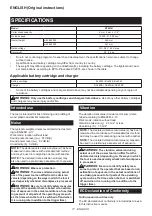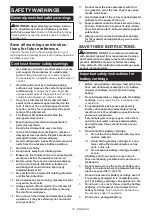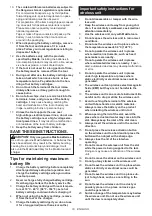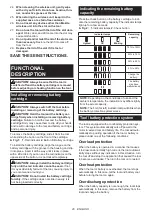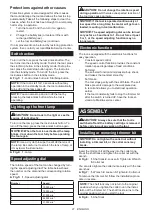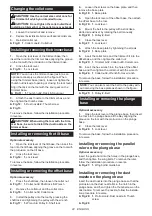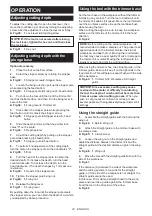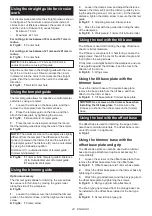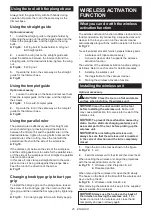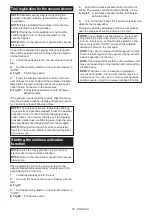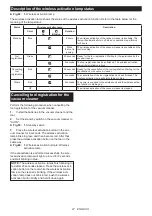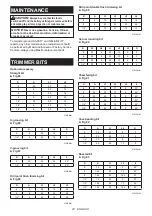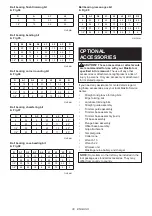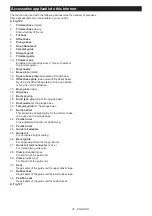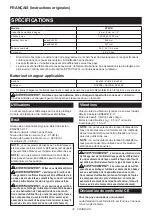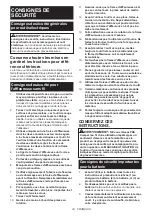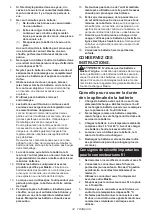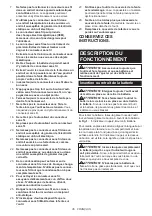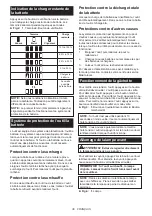
23 ENGLISH
OPERATION
Adjusting cutting depth
To adjust the cutting depth, open the lock lever, then
move the tool base up or down by turning the adjusting
screw. After the adjustment, close the lock lever firmly.
►
Fig.30:
1.
Lock lever
2.
Adjusting screw
NOTICE:
If the tool is not secured after closing
the lock lever, tighten the hex nut, and then close
the lock lever.
►
Fig.31:
1.
Hex nut
Adjusting cutting depth with the
plunge base
Optional accessory
1.
Place the tool on the flat surface.
2.
Select the stopper screw by rotating the stopper
base.
►
Fig.32:
1.
Stopper screw
2.
Stopper base
3.
Loosen the fixing nut, then pull up the stopper pole
while pressing the feed button.
►
Fig.33:
1.
Stopper pole
2.
Fixing nut
3.
Feed button
4.
Push down the tool until the tip of the trimmer bit
touches the flat surface, and then turn the fixing lever to
secure the tool.
►
Fig.34:
1.
Fixing lever
2.
Trimmer bit
5.
Press down the stopper pole while pressing the
feed button until it contacts the stopper screw.
►
Fig.35:
1.
Stopper pole
2.
Stopper screw
3.
Feed
button
6.
Slide the depth pointer so that the pointer indi-
cates "0" on the scale.
►
Fig.36:
1.
Depth pointer
7.
Adjust the cutting depth by pulling up the stopper
pole while pressing the feed button.
►
Fig.37:
1.
Stopper pole
2.
Feed button
8.
To perform fine adjustment of the cutting depth,
turn the dial on the stopper pole so that it indicates "0".
►
Fig.38:
1.
Dial
9.
Turn the head of the stopper pole to obtain the
desired depth. To increase the depth, turn the head
counterclockwise. To decrease the depth, turn the
head clockwise. (The depth changes by 1 mm per one
revolution.)
►
Fig.39:
1.
Head of the stopper pole
10.
Tighten the stopper pole fixing nut.
►
Fig.40:
1.
Fixing nut
11.
Release the fixing lever.
►
Fig.41:
1.
Fixing lever
By pushing down the tool until the stopper pole meets
the stopper screw, you can obtain the depth of cut which
you adjusted by above procedure.
Using the tool with the trimmer base
Set the tool base on the workpiece without the trimmer
bit making any contact. Turn the tool on and wait until
the trimmer bit attains full speed. Move the tool forward
over the workpiece surface. Keep the tool base flush
while moving the tool.
When cutting the edge, be sure to keep the workpiece
surface on the left side of the trimmer bit in the feed
direction.
►
Fig.42
NOTE:
Before cutting on the actual workpiece, it is
recommended to make a sample cut. The proper feed
speed depends on the trimmer bit size, the kind of
workpiece, and depth of cut. Moving the tool forward
too fast may cause a poor quality of cut, or damage to
the trimmer bit or motor. Moving the tool forward too
slowly may burn and mar the cutting surface.
When using the trimmer shoe, the straight guide, or the
trimmer guide, be sure to keep it on the right side in the
feed direction. This will help to keep it flush with the side
of the workpiece.
►
Fig.43:
1.
Trimmer bit
2.
Workpiece
3.
Straight
guide
NOTICE:
Since excessive cutting may cause
overload of the motor or difficulty in controlling
the tool, the depth of cut should not be more than
3 mm at a pass when cutting grooves.
When you
wish to cut grooves more than 3 mm deep, make
several passes with progressively deeper trimmer bit
settings.
Using the straight guide
1.
Assemble the straight guide with the bolt and the
wing nut.
►
Fig.44:
1.
Bolt
2.
Wing nut
2.
Attach the straight guide to the trimmer base with
the clamp screw.
►
Fig.45:
1.
Clamp screw
3.
Loosen the wing nut on the straight guide and
adjust the distance between the trimmer bit and the
straight guide. At the desired distance, tighten the wing
nut.
►
Fig.46:
1.
Wing nut
4.
Move the tool with the straight guide flush with the
side of the workpiece.
►
Fig.47
If the distance (A) between the side of the workpiece
and the cutting position is too wide for the straight
guide, or if the side of the workpiece is not straight, the
straight guide cannot be used.
In this case, firmly clamp a straight board to the work
-
piece and use it as a guide against the trimmer base.
Feed the tool in the direction of the arrow.
►
Fig.48
Содержание RT001G
Страница 2: ...2 2 3 1 Fig 1 1 2 Fig 2 1 2 Fig 3 1 Fig 4 1 Fig 5 1 2 3 4 5 Fig 6 1 4 2 3 1 Fig 7 1 Fig 8 ...
Страница 3: ...3 1 2 Fig 9 1 Fig 10 1 3 2 Fig 11 2 1 Fig 12 Fig 13 1 Fig 14 ...
Страница 4: ...4 1 2 3 Fig 15 1 2 Fig 16 1 2 3 Fig 17 1 Fig 18 1 Fig 19 2 1 Fig 20 1 Fig 21 1 Fig 22 ...
Страница 5: ...5 1 2 3 Fig 23 1 2 3 Fig 24 2 1 Fig 25 1 Fig 26 1 2 Fig 27 1 2 3 Fig 28 Fig 29 ...
Страница 6: ...6 1 2 Fig 30 1 Fig 31 1 2 Fig 32 1 2 3 Fig 33 1 2 Fig 34 1 2 3 Fig 35 1 Fig 36 1 2 Fig 37 ...
Страница 7: ...7 1 Fig 38 1 Fig 39 1 Fig 40 1 Fig 41 Fig 42 1 3 2 Fig 43 2 1 Fig 44 1 1 Fig 45 ...
Страница 8: ...8 1 Fig 46 Fig 47 A Fig 48 1 Fig 49 1 Fig 50 2 1 Fig 51 1 2 Fig 52 Fig 53 ...
Страница 9: ...9 1 2 3 4 5 6 Fig 54 Fig 55 1 Fig 56 1 2 Fig 57 1 2 3 Fig 58 1 Fig 59 1 2 Fig 60 Fig 61 ...
Страница 10: ...10 1 2 Fig 62 1 2 Fig 63 1 2 Fig 64 1 2 3 4 Fig 65 1 Fig 66 Fig 67 1 2 Fig 68 ...
Страница 11: ...11 Fig 69 Fig 70 A Fig 71 1 2 3 Fig 72 Fig 73 1 Fig 74 ...
Страница 12: ...12 1 4 2 3 Fig 75 1 2 3 Fig 76 1 Fig 77 1 2 1 2 Fig 78 Fig 79 1 Fig 80 2 1 Fig 81 1 Fig 82 ...
Страница 13: ...13 1 Fig 83 1 2 1 2 Fig 84 D L1 L2 A Fig 85 L2 L1 D A R Fig 86 θ θ θ D L2 L1 A Fig 87 Fig 88 Fig 89 Fig 90 ...
Страница 14: ...14 Fig 91 Fig 92 θ θ θ D L2 L1 A Fig 93 Fig 94 Fig 95 Fig 96 Fig 97 Fig 98 ...
Страница 16: ...16 25 24 30 28 29 31 32 Fig 101 ...
Страница 182: ...182 ...
Страница 183: ...183 ...









